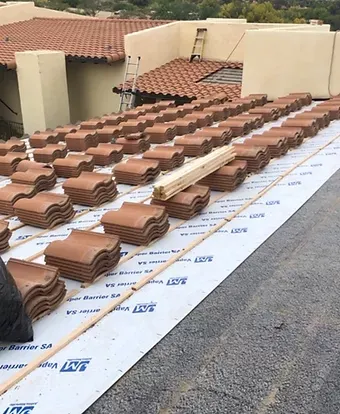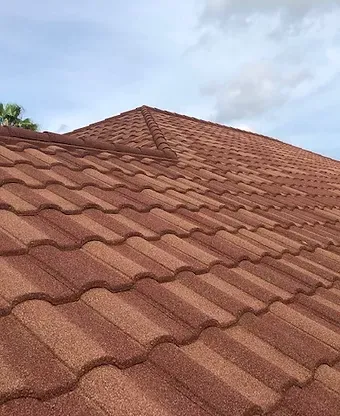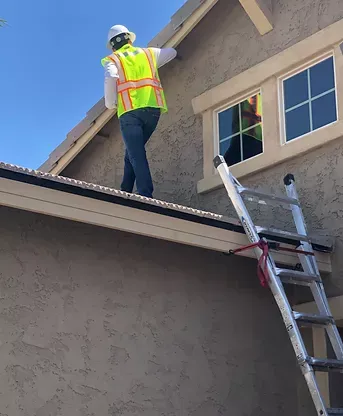Stone Coated Steel Roofing: A Durable and Stylish Choice

What is Stone Coated Steel Roofing?
Stone coated steel roofing is a modern roofing solution that combines the strength and durability of steel with the aesthetic appeal of traditional roofing materials. At its core, this roofing system consists of a galvanized or aluminum-zinc alloy-coated steel base, which is then covered with a layer of stone granules. These granules are bonded to the steel using a durable acrylic adhesive, creating a surface that is not only visually appealing but also highly resistant to the elements.
What sets stone coated steel roofing apart is its ability to mimic the look of classic roofing materials such as clay tiles, wood shakes, or asphalt shingles, while offering superior performance. This innovative roofing option is designed to withstand harsh weather conditions, resist fire, and provide long-lasting protection for homes and buildings. Its unique combination of form and function makes it an increasingly popular choice for homeowners seeking a balance between style and durability.
Key Benefits of Stone Coated Steel Roofing
Durability and Longevity
One of the standout features of stone coated steel roofing is its exceptional durability. Unlike traditional roofing materials that may crack, warp, or deteriorate over time, stone coated steel is built to last. It is highly resistant to extreme weather conditions, including heavy rain, snow, hail, and high winds. Additionally, its non-combustible nature provides excellent fire resistance, making it a safe choice for areas prone to wildfires.
The longevity of stone coated steel roofing is another major advantage. While asphalt shingles may need replacement every 15-20 years, stone coated steel roofs can last 50 years or more with proper maintenance. This extended lifespan makes it a cost-effective investment in the long run.
Energy Efficiency
Stone coated steel roofing is not just about durability—it also contributes to energy efficiency. Its reflective surface helps to deflect sunlight, reducing heat absorption and keeping your home cooler during hot summer months. This can lead to significant savings on cooling costs, especially in regions with intense sunlight. Some stone coated steel roofing systems are even designed with additional insulation layers, further enhancing their energy-saving capabilities.
Low Maintenance
Compared to other roofing materials, stone coated steel requires minimal upkeep. Its robust construction resists common issues like mold, mildew, and insect infestations. Unlike wood shakes that may need regular treatments or asphalt shingles that can curl and crack, stone coated steel roofs maintain their integrity with little effort. Occasional cleaning and inspections are usually sufficient to keep them in top condition.
Stylish Design Options for Stone Coated Steel Roofing
One of the most appealing aspects of stone coated steel roofing is its versatility in design. Homeowners can choose from a wide range of styles, textures, and colors to match their aesthetic preferences. Whether you prefer the rustic charm of wood shakes, the classic elegance of clay tiles, or the sleek look of asphalt shingles, stone coated steel can replicate these appearances with remarkable accuracy.
The variety of design options ensures that stone coated steel roofing complements virtually any architectural style, from traditional to contemporary. For instance, Mediterranean-style homes can benefit from tile-like profiles, while modern homes may opt for clean, minimalist designs. The ability to customize the look of your roof without sacrificing durability makes stone coated steel a standout choice for discerning homeowners.
Installation Process and Considerations
Steps Involved in Installation
Installing stone coated steel roofing is a precise process that requires professional expertise. The process typically begins with an assessment of the existing roof structure to ensure it can support the new roofing system. Next, a waterproof underlayment is applied to provide an additional layer of protection. The stone coated steel panels are then installed, starting from the bottom edge of the roof and working upward. Each panel is securely fastened to the roof deck, ensuring stability and resistance to wind uplift.
Importance of Professional Installation
While the installation process may seem straightforward, it is crucial to hire experienced professionals for the job. Proper installation is key to maximizing the performance and lifespan of stone coated steel roofing. Mistakes during installation, such as improper fastening or inadequate sealing, can compromise the roof's durability and weather resistance.
Compatibility with Existing Roof Structures
Stone coated steel roofing is lightweight compared to materials like clay or concrete tiles, making it compatible with most existing roof structures. However, a thorough inspection is necessary to address any structural issues before installation. In some cases, minor reinforcements may be required to ensure the roof can handle the new system.
Comparing Stone Coated Steel Roofing to Other Roofing Materials
Asphalt Shingles
While asphalt shingles are a popular choice due to their affordability, they fall short in terms of durability and lifespan. Asphalt shingles typically last 15-20 years and are prone to damage from extreme weather. In contrast, stone coated steel roofing offers superior longevity and resistance to the elements, making it a better long-term investment despite its higher upfront cost.
Clay and Concrete Tiles
Clay and concrete tiles are known for their aesthetic appeal and durability, but their heavy weight can pose challenges during installation. Stone coated steel roofing provides a similar look without the added weight, making it easier to install and compatible with a wider range of structures. Additionally, stone coated steel requires less maintenance compared to clay and concrete tiles, which can crack or chip over time.
Wood Shake
Wood shake roofs offer a natural, rustic appearance but are susceptible to fire, rot, and insect damage. Stone coated steel roofing can replicate the look of wood shakes while eliminating these vulnerabilities. Its fire-resistant properties and low maintenance requirements make it a safer and more practical choice.
Environmental Benefits of Stone Coated Steel Roofing
Stone coated steel roofing is an eco-friendly option for environmentally conscious homeowners. The steel used in these roofing systems is often made from recycled materials, and the roofs themselves are fully recyclable at the end of their lifespan. This reduces waste and minimizes the environmental impact of roofing replacements.
Additionally, the energy efficiency of stone coated steel roofing contributes to a lower carbon footprint. By reducing the need for air conditioning, these roofs help conserve energy and decrease greenhouse gas emissions. Choosing stone coated steel roofing is not only a smart financial decision but also a step toward sustainable living.
Cost Analysis: Is Stone Coated Steel Roofing Worth the Investment?
While the initial cost of stone coated steel roofing is higher than that of asphalt shingles, its long-term benefits make it a worthwhile investment. The extended lifespan, minimal maintenance requirements, and energy savings contribute to a lower total cost of ownership over time. Homeowners can also enjoy increased property value, as stone coated steel roofing is often seen as a premium feature.
When compared to other high-end roofing materials like clay tiles or wood shakes, stone coated steel offers a competitive value proposition. Its combination of durability, style, and energy efficiency ensures that homeowners get the most out of their investment.
Maintenance Tips for Stone Coated Steel Roofing
To keep your stone coated steel roof in top condition, follow these maintenance tips:
- Regular Inspections : Check for any signs of damage, such as loose panels or missing granules, especially after severe weather.
- Cleaning : Remove debris like leaves and branches to prevent water buildup. Use a soft brush or low-pressure water spray to clean the surface.
- Address Minor Repairs Promptly : Fix small issues, such as scratches or dents, to prevent them from escalating into larger problems.
- Professional Maintenance : Schedule periodic inspections and maintenance by a roofing professional to ensure optimal performance.
By following these simple steps, you can extend the lifespan of your stone coated steel roof and maintain its aesthetic appeal.
Common Myths and Misconceptions About Stone Coated Steel Roofing
Myth: Stone Coated Steel Roofs Are Noisy
A common misconception is that stone coated steel roofs are noisy during rain or hail. In reality, the stone coating and underlayment act as sound barriers, reducing noise levels to those of traditional roofing materials.
Myth: Installation Is Complicated
While professional installation is recommended, the process is not overly complex. Experienced contractors can install stone coated steel roofing efficiently, ensuring a seamless fit.
Myth: Limited Design Options
Some believe that stone coated steel roofing lacks variety in design. On the contrary, it offers a wide range of styles, colors, and textures to suit any architectural preference.
Choosing the Right Stone Coated Steel Roofing Manufacturer
When selecting a manufacturer, consider the following factors:
- Warranty : Look for manufacturers that offer comprehensive warranties, as this reflects confidence in their product quality.
- Reputation : Research customer reviews and testimonials to gauge the reliability of the manufacturer.
- Product Quality : Ensure the roofing system meets industry standards for durability and performance.
Take the time to compare options and consult with professionals to make an informed decision.




